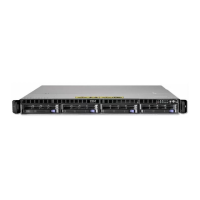System Power-On Methods
This section discusses the following system power-on methods:
v Power-on switch
v Service processor menus
Privileged users can power on the system by selecting the System Control Power
Menu option from the main menu and then selecting the Power-on System option
from the system power control menu. General users should select Power-on System
on the general user menu.
v Remote power-on via ring-indicate signal
The server automatically powers on when it detects a ″ring-indicate″ signal from a
modem attached to serial port 1 (S1) or serial port 2 (S2).
A remote user can call the server to activate ring detection by the modem. Listen for
a few more rings than the threshold number for starting the system. The system
powers on without answering the call.
v Unattended start mode - refer to Enable/Disable Unattended Start Mode on page
378.
The service processor can be enabled to recover from the loss of ac power (dc
power in a dc-powered system) (see Enable/Disable Unattended Power-On Mode in
the System Control Power Menu). When ac power (dc power in a dc-powered
system) is restored, the system returns to the power state at the time ac loss (dc loss
in a dc-powered system) occurred. For example, if the system was powered on when
ac loss (dc loss in a dc-powered system) occurred, it reboots/restarts when power is
restored. If the system was powered-off when ac loss (dc loss in a dc-powered
system) occurred, it remains off when power is restored.
It is recommended that the CEC and I/O drawers both receive their ac power (dc
power in a dc-powered system) from the same building circuit on the same circuit
breaker, if not the same electrical outlet box, in such a way that primary power
cannot be lost to one unit separately from the other. If such a condition occurs,
unattended start mode may not be able to restart system operation when a primary
power interruption is restored.
v Timed power-on - refer to the shutdown -t command on servers using AIX.
Working in conjunction with AIX, the service processor in your server can operate a
timer, much like the wake-up timer on your clock radio. You can set the timer so that
your server powers on at a certain time after shutting down. The timer is
battery-operated, so power interruptions that occur while the server is off do not
affect its accuracy. Refer to the AIX shutdown -t command for details on setting the
timer.
Note: If an ac power (dc power in a dc-powered system) loss is in progress when
the timed power-on attempt occurs, the server is not able to power on when
ac power (dc power in a dc-powered system) is restored.
v Follow-up to a failed boot attempt
The service processor initiates a power-on sequence if a failed boot attempt is
detected (due to a hardware or software failure).
v Fast/slow boot (IPL) settings
398 Service Guide

